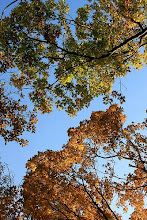
According to the inscription at the statue at Case Point:
When Lewis and Clark stopped at this spot on September 15, 1806, atop a high bluff with a sweeping view of the Missouri River Valley, they noted that the site offered a "commanding situation for a fort."
The sign notes that although the site overlooking the mouth of the Kansas River seemed like an ideal spot for a fort, no fort was ever built here.

Last week, however, I found evidence to the contrary. Sure, it's nothing too formidable from a military standpoint, but the careful arrangement of sticks and plastic shows a lot of ingenuity went into the making of this structure.

So, you see, there is a fort at Case Point after all. And yes, I did have ethical qualms about sharing this online, but considering it's on public land that's viewable from the highway, and in light of its historical significance, I opted to go ahead and post it.
Another fun fact about Lewis and Clark's journey through this area. It was near this place that Clark saw a dazzling sight -- an immense flock of Carolina parakeets. This was the first documented sighting of these now extinct birds west of the Mississippi.
Must have been pretty.




No comments:
Post a Comment